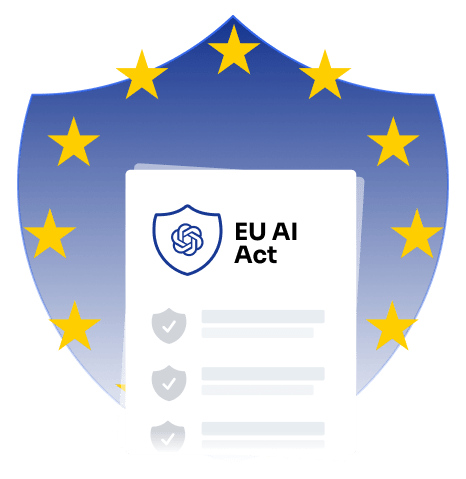Introduction
The European Union’s recent introduction of the AI Act represents a major breakthrough in regulating artificial intelligence (AI) systems, particularly those considered high-risk. The legislation provides a much-needed framework for deploying and managing AI technologies in the European market. Specifically, this article aims to provide in-depth insights into conformity assessments under the EU AI Act.
By exploring the key aspects that shape the conformity assessment process, readers will gain a comprehensive understanding of the requirements that must be met to ensure that AI systems are safe, transparent, and accountable. Such an understanding is crucial in navigating the complex and ever-evolving landscape of AI regulation in the European Union.
Understanding the EU AI Act
The proposed EU AI Act, which has been put forth by the European Commission, is a comprehensive legal framework that aims to address the risks associated with AI systems. This act aims to position Europe as a leader in global AI governance by prioritizing the deployment of trustworthy AI. This framework emphasizes the need for conformity assessments to ensure that AI systems are deployed safely and reliably.
By establishing a clear set of guidelines and standards for the deployment of AI, the EU AI Act seeks to promote transparency, accountability, and the protection of fundamental rights and values. Ultimately, this will help build public trust in AI systems, which is essential for their widespread adoption and acceptance.
Categorization of AI systems
The use of AI systems is governed by a particular Act, which categorizes them into different risk levels. This categorization is particularly crucial for high-risk AI systems that have the potential to affect fundamental rights, such as life and health insurance.
The classification of AI applications into various risk levels serves as a useful guide for determining the level of scrutiny and thoroughness required for conformity assessments. This approach depends on the potential risks posed by the AI system. By doing so, the Act aims to ensure that AI technology aligns with ethical and legal principles and does not undermine human rights, privacy, or safety.
The Act’s provisions require a more in-depth assessment of high-risk AI systems to ensure compliance with safety, security, and data protection regulations. It also mandates that developers of such systems must conduct thorough testing and verification to identify and mitigate potential risks.
Role of conformity assessments
Conformity assessments are a critical component of the AI industry, playing a pivotal role in ensuring that AI systems are developed and implemented in accordance with the specified regulatory standards. These assessments involve a rigorous and comprehensive evaluation of technical documentation, internal conformity assessments, and risk management systems associated with AI models. Conformity assessments are typically conducted by independent third-party organizations, which specialize in evaluating and certifying AI systems’ safety, reliability, and efficacy.
The assessment process involves a detailed review of the AI system’s design, architecture, algorithms, data sets, and operating procedures to identify potential risks or compliance issues. The ultimate goal of conformity assessments is to ensure that AI systems are safe, reliable, and trustworthy and do not threaten human health, safety, or privacy.

Third-party conformity assessment providers
The European Union’s AI Act has paved the way for third-party conformity assessment providers, also known as notified bodies, to assess the compliance of AI systems with the regulations that have been established. These notified bodies work independently to ensure objectivity and effectiveness in the conformity assessment process. This means that they are not affiliated with the companies that develop or manufacture the AI systems, and they assess the systems based on the established criteria and standards.
These assessments aim to ensure that AI systems are safe, ethical, and transparent and do not pose any risks to human health or safety. The role of notified bodies in the conformity assessment process is critical to building trust in AI systems, and it enables companies to demonstrate that their AI systems are compliant with the regulations.
Involvement of public authorities
The conformity assessment process involves evaluating products, services, or processes to ensure that they meet the relevant standards and regulations. Notified bodies are responsible for conducting such assessments, but public authorities also play a pivotal role in overseeing and validating these evaluations.
By doing so, they ensure that the assessments are conducted fairly, transparently, and reliably. This involvement of public authorities enhances the accountability of the conformity assessment process and promotes responsible AI deployment, a key objective of the European Union.
Human oversight measures
The European Union’s AI Act has been established to ensure that AI practices are conducted in a responsible manner. One of the key provisions of this act is that high-risk AI systems must have human oversight measures in place. These measures are intended to ensure that AI technologies are transparent, reliable, and free from biases or errors.
To achieve this, the act mandates clear guidelines on the involvement of human decision-makers in developing and using high-risk AI systems. Additionally, it requires the implementation of mechanisms to detect and address any biases or errors that may arise in these technologies. By doing so, the EU hopes to promote the ethical and responsible use of AI while also fostering innovation and growth in this exciting field.
Post-market monitoring and compliance
As per the Act, it is important to closely monitor AI systems after they have been deployed in the market. This monitoring is necessary to ensure that the systems are functioning in compliance with the regulatory standards that have been established for their use. Any deviations from these standards must be detected and addressed to maintain high standards in AI deployment.
In cases where non-compliance is detected, corrective actions will be taken to ensure that the AI system meets the regulatory standards. Depending on the severity of the non-compliance, these actions could range from minor adjustments to significant modifications or even removal of the system from the market.
The Act’s emphasis on post-market monitoring and corrective actions underscores the importance of maintaining high-quality standards in deploying AI systems. By adhering to these standards, we can ensure that AI technologies are being used safely and effectively without posing any unnecessary risks to users or the broader public.

Risk management and unacceptable risk
To ensure the safe and responsible deployment of AI systems, conformity assessments play a key role in identifying and managing potential risks. These assessments involve a thorough risk management process that considers various factors, such as the intended use of the system, the potential impact on individuals and society, and the level of autonomy of the system.
The recently passed Act on AI explicitly addresses unacceptable risks and sets clear parameters for what is ethically and legally acceptable in AI deployment. This includes requirements for transparency, accountability, and explainability of AI systems, as well as measures to prevent discrimination and protect privacy.
By establishing a framework for responsible AI deployment, the Act aims to promote innovation and growth in the AI industry while ensuring that AI systems are developed and used in a way that benefits society.
Transparency obligations
In recent years, there has been a growing recognition of the need for transparency in developing and deploying AI technologies. This recognition stems from the fact that AI systems are becoming increasingly complex and opaque, making it difficult for users and other stakeholders to understand how they work and why they make their own decisions. As a result, there is a growing consensus that AI providers must be more transparent about their operations, particularly with respect to the functioning and decision-making processes of their AI technologies.
This commitment to transparency is especially important in the European Union, where there is a strong emphasis on ensuring that AI practices are understandable and explainable. This emphasis is grounded in the belief that AI should be developed and used to promote human welfare and that this can only be achieved if the technology is subject to scrutiny and accountability.
As a result, AI providers in the EU are expected to be transparent about the data they use to train their AI systems, the algorithms they use to make decisions, and the ethical principles that guide their development and deployment. This transparency is seen as essential to building trust in AI technologies and ensuring that they are used in a way that benefits society.
Ethical principles in AI policy
As per the recently introduced EU AI Act, ethical principles have been integrated into its policy framework, emphasizing the importance of responsible AI deployment. This is an important step in ensuring that the use of AI is aligned with fundamental rights and values. The act has set out a clear framework for the ethical use of AI in critical infrastructures and law enforcement purposes.
This includes a range of considerations, such as promoting transparency and accountability in deploying AI systems, ensuring that they are non-discriminatory, and protecting the privacy and security of individuals. By doing so, the EU AI Act seeks to foster trust in AI systems and promote their responsible and ethical use.

Technical solutions and harmonized rules
The Act seeks to promote the development and deployment of advanced AI systems that are technically sound and robust. To achieve this, the Act encourages the creation of technical solutions that can be implemented across the EU member states. By establishing harmonized rules and regulations for all member states, the Act aims to create a cohesive regulatory framework that supports innovation while maintaining high standards in AI technologies.
The ultimate goal is to ensure that AI systems are safe, reliable, and trustworthy and that they can benefit society in a wide range of areas, from healthcare and education to transportation and manufacturing. By providing a clear and consistent regulatory environment, the Act aims to promote the responsible development and use of AI technologies while also helping to build public trust in these technologies over time.
Governance process and implementing acts
The European Union’s AI Act has established a comprehensive governance process that involves the issuance of implementing acts to provide detailed specifications on various aspects of AI regulation. These implementing acts are meant to ensure that the regulatory framework for AI is dynamic and adaptable, allowing it to keep pace with the rapidly evolving landscape of AI technologies.
By providing detailed guidance on issues such as transparency, accountability, and risk management, the implementing acts promote the safe and ethical development and deployment of AI systems in the EU. This approach is intended to foster innovation while protecting individuals’ fundamental rights and values.
Legal certainty and European Standardization Organizations
The European Union’s AI Act is centered on ensuring legal certainty concerning the use of AI technology. This involves the provision of clear guidelines and regulations for AI providers to follow to promote responsible and ethical use of the technology.
Additionally, European Standardization Organizations actively contribute to developing harmonized standards, which enhances legal certainty and ensures consistency in AI deployment across the European Union. By implementing these measures, the EU seeks to foster an environment that encourages the safe and trustworthy use of AI technology while also promoting innovation and competitiveness in the field.
Conclusion
The EU AI Act represents an important step towards a more responsible and sustainable use of artificial intelligence. By establishing clear guidelines for developing, deploying, and monitoring AI systems, the Act aims to promote trust, transparency, and accountability in the European market. The emphasis on risk-based assessments and human oversight is particularly noteworthy, underscoring the need to prioritize safety, privacy, and fundamental rights in AI applications.
Moreover, integrating ethical principles and values into the regulatory framework signals a commitment to promoting innovation aligned with societal values and expectations. As such, the EU AI Act can serve as a model for other regions and countries seeking to establish a sound and ethical AI governance framework.




